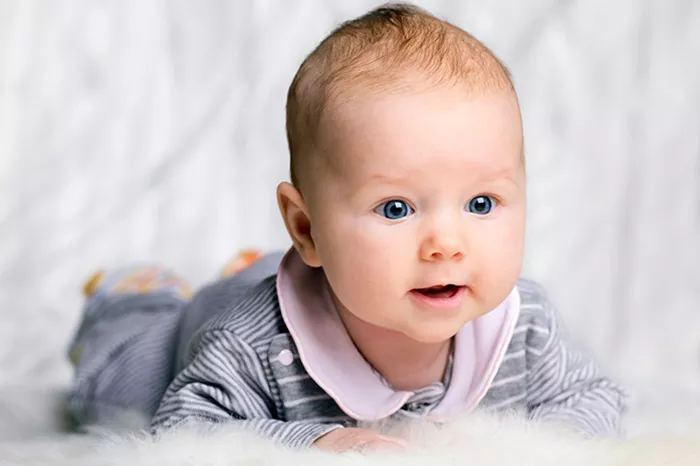Newborns’ vision is one of the least developed senses at birth. As they grow, their visual abilities rapidly improve. At three weeks old, a baby’s vision is still in the early stages of development. Understanding what newborns can see at this age involves recognizing the limitations and gradual improvements in their visual capabilities.
Visual Development in Newborns
Newborn Vision: The Basics
At birth, a newborn’s vision is blurry. They see the world primarily in shades of gray. Their eyes are sensitive to light but cannot focus well on objects. Newborns’ eyes are anatomically immature, with the retinas, which are essential for processing visual information, still developing.
Focus and Clarity
At three weeks, babies can see objects that are about 8 to 12 inches away from their face. This distance is perfect for seeing the face of a parent during feeding. Babies can focus on objects within this range but anything beyond it remains blurry. Their ability to focus on closer objects starts to improve, though it’s not yet perfect.
Contrast and Color Vision
Initially, newborns are more sensitive to high-contrast patterns rather than detailed images. Bold, contrasting colors and shapes, such as black and white, are easier for them to see. At three weeks, while they might start to see some colors, their color vision is still developing. Babies at this age tend to prefer high contrast and bright colors, as these are more stimulating and easier to discern.
Tracking Movement
By three weeks, newborns start to show some ability to track moving objects. Their eyes can follow slow movements within their limited range of vision. This tracking ability is rudimentary and will continue to develop over the coming months. Newborns might momentarily fixate on an object but can easily lose track of it if it moves too quickly.
Facial Recognition
Faces are one of the most important visual stimuli for newborns. By three weeks, babies show a preference for looking at faces over other objects. They are particularly drawn to their mother’s face, which they are exposed to most frequently. This preference helps in bonding and attachment. Babies can start to recognize familiar faces, especially when combined with familiar sounds like a parent’s voice.
Depth Perception
Depth perception in newborns is very limited. At three weeks, they do not have a well-developed sense of depth. Their eyes are still learning to work together to create a three-dimensional view of the world. This skill, known as binocular vision, will develop over the next few months.
Visual Stimulation and Growth
Stimulating a newborn’s vision can aid in their development. Simple, high-contrast toys or images can be used to encourage visual tracking and focus. Regularly changing the visual environment around the baby helps in exposing them to different shapes and patterns, aiding their visual development. Interaction with parents and caregivers, through face-to-face time, is crucial for visual and emotional growth.
SEE ALSO: What a Newborn Can See at 1 Week?
Common Concerns and Observations
Parents often worry about whether their baby’s vision is developing normally. It’s important to remember that variations in visual development are common. Some newborns might develop tracking and focusing abilities slightly earlier or later than others. Routine pediatric check-ups usually include basic vision screening to ensure the baby’s eyes are developing correctly.
Signs of Potential Issues
While most newborns will develop their vision normally, there are some signs that might indicate potential problems. These include:
Lack of response to visual stimuli
Inability to track objects or faces
Consistent crossing or misalignment of the eyes
Excessive tearing or discharge from the eyes
If any of these signs are observed, it’s important to consult a pediatrician for further evaluation.
Parental Support and Encouragement
Parents play a vital role in their baby’s visual development. Simple activities can help in nurturing their vision:
Holding the baby close during feedings to facilitate facial recognition
Using toys and objects with high-contrast patterns
Changing the baby’s position frequently to offer different visual perspectives
Engaging in face-to-face interaction with plenty of eye contact
Developmental Milestones to Anticipate
As babies grow, their vision continues to improve. By the time they reach three months, their ability to focus and track objects will be much better. They will start to see more colors and show interest in more complex patterns. Depth perception will begin to develop as they start to reach for objects, enhancing their hand-eye coordination.
Conclusion
At three weeks old, a newborn’s vision is still developing. They can see objects clearly only within a close range of about 8 to 12 inches and are sensitive to high-contrast patterns rather than detailed images. Their ability to focus, track movement, and perceive colors is limited but gradually improving. Newborns are particularly drawn to faces, especially those of their parents, which helps in bonding and attachment. Depth perception is not yet developed, and their eyes are still learning to work together for a three-dimensional view of the world.
Visual stimulation, such as high-contrast toys and face-to-face interaction, supports visual development. Most variations in visual development are normal, but parents should monitor for signs of potential issues, such as lack of response to visual stimuli or eye misalignment. Regular pediatric check-ups help ensure healthy visual development. As babies grow, their vision improves significantly, with better focusing, tracking, and color perception developing over the next few months.


